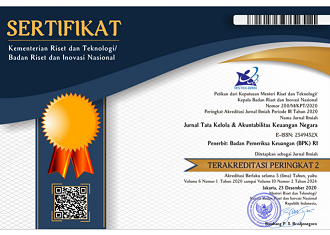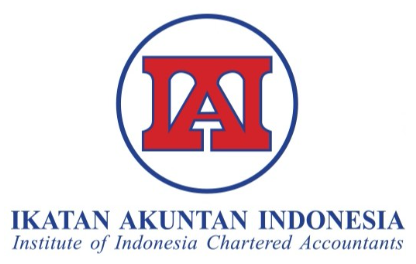An Investigation of Audit Expectation Gap in Indonesia’s Public Sector
DOI:
https://doi.org/10.28986/jtaken.v8i1.674Keywords:
Audit expectation gap, Public sector, Audit report, Responsibility perception, Unqualified audit opinionAbstract
The audit expectation gap has been studied since the early 1970s, and several approaches have been used to resolve this problem. However, such a gap persists both in the private and public sectors. Meanwhile, there are only a few studies related to this topic in the public sector, so the need to undertake more research in this area is encouraged. This study investigates to what extent the audit expectation gap occurs in Indonesia’s public sector. It also examines the effectiveness of the additional information in the audit report as mandated by the state financial auditing standards (SPKN, 2017) in closing the gap. A questionnaire was developed and administered to auditors, government officers, and students to capture their views. ANCOVA and Kruskal-Wallis were used to analyze the data collected from the questionnaires. The study discovered that the audit expectation gap in Indonesia’s public sector is related to the auditor’s responsibility. Such a gap is also found in frauds and errors in unqualified financial statements.
References
Anderson, B., Maletta, M., & Wright, A. (1998). Perceptions of auditor responsibility: Views of the judiciary and the profession. International Journal of Auditing, 2(3), 215–232. DOI: 10.1111/1099-1123.00041
Best, P. J., Buckby, S., & Tan, C. (2001). Evidence of the audit expectation gap in Singapore. Managerial Auditing Journal, 16(3), 134-144. DOI: 10.1108/ 02686900110385579
BPK RI. (2017). BPK Regulation Number 1 Year 2017 concerning State Financial Audit Standards (Peraturan BPK RI Nomor 1 Tahun 2017 tentang Standar Pemeriksaan Keuangan Negara). Retrieved from https://www.bpk.go.id/ page/standar-pemeriksaan-keuangan -negara
Bryman, A. (2016). Social research methods (5th ed.). Oxford: Oxford University Press.
Chong, K. M., & Pflugrath, G. (2008). Do different audit report formats affect shareholders' and auditors' perceptions? International Journal of Auditing, 12(3), 221-241. DOI: 10.1111/j.1099-1123.2008.00381.x
Chowdhury, R. R., Innes, J., & Kouhy, R. (2005). The public sector audit expectations gap in Bangladesh. Managerial Auditing Journal, 20(8), 893-908. DOI: 10.1108/02686900510619719
Cramer, D. (1994). Introducing statistics for social research: Step-by-step calculations and computer techniques using SPSS. London: Routledge.
Dana, G. (2011). Audit expectation gap in the public sector in Romania, European Integration. Paper presented at the New Challenges Conference, Oradea, Romania.
Fadzly, M. N., & Ahmad, Z. (2004). Audit expectation gap: The case of Malaysia. Managerial Auditing Journal, 19(7), 897-915. DOI: 10.1108/026869004 10549420
Gold, A., Gronewold, U., & Pott, C. (2012). The ISA 700 auditor's report and the audit expectation gap - Do explanations matter? International Journal of Auditing, 16(3), 286-307.
Government Regulation Number 71 of 2010 concerning Government Accounting Standards (Peraturan Pemerintah Nomor 71 Tahun 2010 tentang Standar Akuntansi Pemerintahan). Retrieved from http://peraturan.go.id/pp/nomor-71-tahun-2010-11e44c4f4fce3ab09f7d 313232303235. html.
Hatherly, D., Innes, J., & Brown, T. (1991). The expanded audit report - An empirical investigation. Accounting and Business Research, 21(84), 311-319. DOI:10.1080/00014788.1991.9729846
Holm, C., & Zaman, M. (2012). Regulating audit quality: Restoring trust and legitimacy. Accounting Forum, 36, 51-61. DOI: 10.1016/j.accfor.2011.11.004
Holt, G., & Moizer, P. (1990). The meaning of audit reports. Accounting and Business Research, 20(78), 111-121. DOI: 10.1080/00014788.1990.9728869
Humphrey, C., Mozier, P., & Turley, S. (1993). The audit expectations gap in Britain: An empirical investigation. Accounting and Business Research, 23(91A), 395-411.
Innes, J., Brown, T., & Hatherly, D. (1997). The expanded audit report: A research study within the development of SAS 600. Accounting, Auditing & Accountability Journal, 10(5), 702-717.
International Organization of Supreme Audit Institutions (INTOSAI). (2013). Fundamental Principles of Public-Sector Auditing (ISSAI 100). Retrieved from http://www.issai.org/en_us/site-issai/issai-framework/3-fundamental-auditing-priciples.htm
International Standard on Auditing (ISA) 700 Revised. (2016). International Standard on Auditing (UK) 700 Revised: Forming an opinion and reporting on financial statements. Retrieved from https://www.frc.org.uk/Our-Work/Publications/Audit-and-Assurance-Team/ISA-%28UK%29-700-Revised-June-2016.pdf
Jones, R., & Pendlebury, M. (2000). Public sector accounting (5th ed.). Harlow: Pearson Education Limited.
Kneer, D. C., Reckers, P. M., & Jennings, M. M. (1996). An empirical examination of the influence of the "New" US Audit Report and fraud red flags on perceptions of auditor culpability. Managerial Auditing Journal, 11(6), 18-30.
Köse, Y., & Erdogan, S. (2015). The audit expectations gap in Turkey. The Journal of Accounting and Finance (Muhasebe ve Finansman Dergisi), 67, 193-214. DOI: 10.25095/mufad.396589
Lin, Z. J., & Chen, F. (2004). An empirical study of audit 'Expectation Gap' in the people's Republic of China. International Journal of Auditing, 115, 93-115.
Litjens, R., Buuren, J. v., & Vergoossen, R. (2015). Addressing Information Needs to Reduce the Audit Expectation Gap: Evidence from Dutch Bankers, Audited Companies, and Auditors. International Journal of Auditing, 19(3), 267-281.
Lowe, D. J. (1994). The expectation gap in the legal system: Perception differences between auditors and judges. Journal of Applied Business Research,10(3), 39-44. DOI: 10.19030/jabr.v10i3.5922
Masoud, N. (2017). An empirical study of audit expectation-performance gap: The case of Libya. Research in International Business and Finance, 41(C), 1-15. DOI: 10.1016/j.ribaf.2017.04.012
Miller, J. R., Reed, S. A., & Strawser, R. H. (1993). Bank Loan Officers' Perceptions of the New Audit Report. Accounting Horizons, 7(1), 39-52.
Monroe, G. S., & Woodliff, D. (1994). An empirical investigation of the audit expectation gap: Australian evidence. Accounting and Finance, 34(1), 47-74.
O'Malley, S. F. (1993). Legal liability is having a chilling effect on the auditor's role. Accounting Horizons, 7(2), 82-87.
Porter, B. (1993). An empirical study of the audit expectation-performance gap. Accounting and Business Research, 24(93), 49-68. DOI: 10.1080/00014788. 1993.9729463
Porter, B., Hógartaigh, C. Ó., & Baskerville, R. (2012). Audit expectation-performance gap revisited: Evidence from New Zealand and the United Kingdom. Part 2: Changes in the gap in New Zealand 1989-2008 and in the United Kingdom 1999-2008. International Journal of Auditing, 16(3), 215-247.
Ruhnke, K., & Schmidt, M. (2014). The audit expectation gap: Existence, causes, and the impact of changes. Accounting and Business Research, 44(5), 572-601. DOI: 10.1080/00014788.2014.929519
Rusliyawati. (2007). Penginvestigasian audit expectation gap pada sektor publik. (Unpublished master’s thesis). Gadjah Mada University, Yogyakarta, Indonesia.
Sekaran, U., & Bougie, R. (2016). Research methods for business (7th ed.). Chichester: John Willey & Sons Ltd.
Setyorini, D. A. (2010). Analisis audit expectation gap pada Pemerintah Daerah: Studi empiris di Kabupaten Sragen. (Unpublished master’s thesis). Sebelas Maret University, Solo, Indonesia.
Sidani, Y. M. (2007). The audit expectation gap: evidence from Lebanon. Managerial Auditing Journal, 22(3), 288-302.
The International Auditing and Assurance Standards Board (IAASB). (2012). Improving the auditor's report: IAASB invitation to comment. Retrieved from https://www.ifac.org/publications-resources/improving-auditor-s-report
Unerman, J., & Deegan, C. (2011). Financial accounting theory (2nd ed.). Maidenhead: McGraw-Hill.
Yandi, D. F. (2015). Analisis variabel-variabel audit expectation gap atas hasil audit BPK: Studi empiris pada Pemerintah Kota Jambi Tahun 2013. Jurnal Akutansi dan Keuangan Unja, 1(1).
Yulianti, R., Winarna, J., & Setiawan, D. (2007). Expectation gap antara pemakai Laporan Keuangan Pemerintah dan auditor pemerintah Paper presented at the Simposium Nasional Akutansi X. Makassar, Indonesia.
Downloads
Submitted
Accepted
Published
How to Cite
Issue
Section
License

Jurnal Tata Kelola dan Akuntabilitas Keuangan Negara is licensed under
a Creative Commons Attribution-ShareAlike 4.0 International License




















